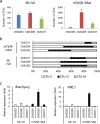BMP4 and perivascular cells promote hematopoietic differentiation of human pluripotent stem cells in a differentiation stage-specific manner
- PMID: 31956269
- PMCID: PMC7000736
- DOI: 10.1038/s12276-019-0357-5
BMP4 and perivascular cells promote hematopoietic differentiation of human pluripotent stem cells in a differentiation stage-specific manner
Abstract
The efficient and reproducible derivation and maturation of multipotent hematopoietic progenitors from human pluripotent stem cells (hPSCs) requires the recapitulation of appropriate developmental stages and the microenvironment. Here, using serum-, xeno-, and feeder-free stepwise hematopoietic induction protocols, we showed that short-term and high-concentration treatment of hPSCs with bone morphogenetic protein 4 (BMP4) strongly promoted early mesoderm induction followed by increased hematopoietic commitment. This method reduced variations in hematopoietic differentiation among hPSC lines maintained under chemically defined Essential 8 medium compared to those maintained under less-defined mTeSR medium. We also found that perivascular niche cells (PVCs) significantly augmented the production of hematopoietic cells via paracrine signaling mechanisms only when they were present during the hematopoietic commitment phase. A protein array revealed 86 differentially expressed (>1.5-fold) secretion factors in PVC-conditioned medium compared with serum-free control medium, of which the transforming growth factor-β inducible gene H3 significantly increased the number of hematopoietic colony-forming colonies. Our data suggest that BMP4 and PVCs promote the hematopoietic differentiation of hPSCs in a differentiation stage-specific manner. This will increase our understanding of hematopoietic development and expedite the development of hPSC-derived blood products for therapeutic use.
Conflict of interest statement
The authors declare that they have no conflict of interest.
Figures





References
-
- Moreno-Gimeno I, Ledran MH, Lako M. Hematopoietic differentiation from human ESCs as a model for developmental studies and future clinical translations. Invited review following the FEBS Anniversary Prize received on 5 July 2009 at the 34th FEBS Congress in Prague. FEBS J. 2010;277:5014–5025. doi: 10.1111/j.1742-4658.2010.07926.x. - DOI - PubMed
Publication types
MeSH terms
Substances
Grants and funding
LinkOut - more resources
Full Text Sources

